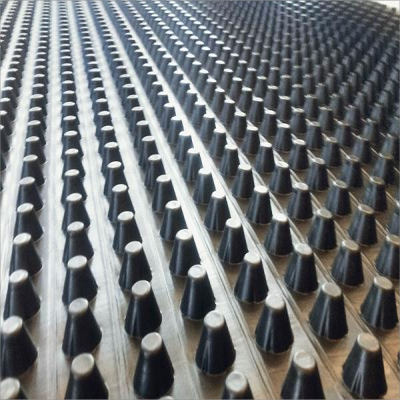1. Design principles
1、Stability: The supporting grid should ensure that the drainage board can be stable after installation and resist external loads and deformation.
2、Adaptability: The grid structure should adapt to different terrain and soil conditions to ensure that the drainage board can be laid smoothly and exert the drainage effect.
3、Economy: On the premise of ensuring quality, reasonably control material costs and production and installation costs to improve project efficiency.
2. Material selection
1、Steel: It has high strength and durability, and is suitable for large-scale projects or occasions requiring high bearing capacity.
2、Plastics: such as polypropylene ( PP)、 Polyethylene ( PE) It has the advantages of light weight, corrosion resistance, easy processing, etc., and is suitable for a variety of terrain and soil conditions.
3、Composite Materials: Combining the advantages of multiple materials, such as FRP grating, it has both the strength of steel and the corrosion resistance and lightweight characteristics of plastic.
3. Production process
1、Material preparation: Choose the appropriate material according to the design requirements and perform the necessary pretreatment such as cutting, sanding, etc.
2、Grid design: Design reasonable grid shape and size according to engineering requirements and drainage board size. The size and spacing of the grids should be comprehensively determined according to factors such as soil conditions, drainage requirements and installation convenience.
3、Molding: Using welding, injection molding or pressing processes to process the material into a grid of the desired shape. The quality should be strictly controlled during the machining process to ensure the flatness and dimensional accuracy of the grid.
4、Surface treatment: Surface treatment of the processed mesh, such as anti-corrosion treatment, anti-rust treatment, etc., can improve its durability and service life.
4. Installation steps
1、Foundation treatment: Clean up the debris and dirt in the construction area to ensure that the foundation surface is clean and smooth. Carry out necessary treatments on the foundation, such as repairing damaged parts, painting waterproofing materials, etc.
2、Line positioning: According to the design requirements, line positioning on the foundation surface to determine the installation position and slope of the supporting grid and drainage board.
3、Installation of support grid: Lay the made support grid on the foundation according to the design requirements, and fix it with special tools to ensure that it is firm and stable. The connection between the grids should be tight and reliable to avoid misalignment or loosening.
4、Laying drainage board: Lay drainage board on support grid, cut and splice according to design requirements. During the laying process, ensure that the drainage board is tightly combined with the supporting grid to avoid gaps or wrinkles.
5、FIXING AND CONNECTION: Use special fixing pieces to fix the drainage board to the support grid to ensure it is firm and reliable. Also seal the joints between the drainage boards to prevent rainwater or groundwater infiltration.
It can be seen from the above that the production and installation of the drainage board support grid is an important link to ensure the stable operation of the drainage board system. Through reasonable design, careful production and standardized installation, the drainage effect of the drainage board can be fully exerted, and the engineering quality and durability can be improved.
Post time: Feb-20-2025




